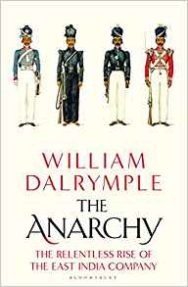‘Money talks, and in the story of the British conquest of India, it talked louder than almost anything else.’
David Robinson has appreciated William Dalrymple’s writing on India for a long time, and in reading Dalrymple’s latest book, he finds a writer as insightful, probing and as gripping as ever.
The Anarchy: The Relentless Rise of the East India Company
By William Dalrymple
Published by Bloomsbury
The reviews are all in for William Dalrymple’s The Anarchy, his history of the rise of the East India Company published last month: I’ve read as many as I can find and they are uniformly excellent. Amidst the panegyrics, there’s not a whiff of criticism. The opening sentence of the author’s note at the end of the book – ‘William Dalrymple is one of Britain’s great historians’ – stands unchallenged.
I’m old enough to remember when that wasn’t the case. In the Nineties, no-one thought of him as a historian at all. He was a travel writer, and had been ever since he left Cambridge and headed off in Marco Polo’s footsteps from Jerusalem to Kubla Khan’s Mongolian summer palace for his prize-winning 1989 debut In Xanadu. India had already a hold on his imagination, but he would never have thought of himself as its historian.
All that had changed by June 2003, when I met him for the first time to interview him about his book White Mughals. It had just won the Scottish Arts Council Book of the Year, and as one of the judges, it fell to me, sitting in the sunny garden of his Queen Anne cottage in Chiswick, to tell him that he could soon expect to be £10,000 richer.
White Mughals is the story of the love between an East India Company representative in Hyderabad and a Mughal princess at the end of the eighteenth century and the beginning off the nineteenth. Not only is it a great story in its own right but it broke new historiographical ground. The relationship between James Achilles Kirkpatrick and Khair-un-Nissa, Dalrymple showed, reflected the times they lived in. Long before the unbridled racism of the Raj, there was ‘a succession of unexpected and unplanned minglings of peoples and cultures and ideas’. Interracial love stories, such as Kirkpatrick’s were part of this and far more common than previously thought.
Back in 2003, Dalrymple didn’t know that White Mughals would go on to be picked by the Richard & Judy Book Club, doubling its sales to 200,000, or that Bloomsbury would woo him with oodles of money for a six-book deal. In fact, at the time, writing history books about India looked like a shortcut to penury. But like his literary hero, Bruce Chatwin, who walked out of a well-paid job at Sotheby’s for the uncertain life of a travel writer, Dalrymple was determined to defy the odds. He spent four years researching and writing the story of Kirkpatrick and Khair-un-Nissa, remortgaging his house and running up a £27,000 overdraft. The day before I met him, his exasperated bank manager had told him he was going to stop honouring his cheques.
It didn’t come to that. On the same day he met the bank manager, he was told that his book had won the £10,000 Wolfson History Prize. The next day, thanks to the Scottish Arts Council, he had twice that amount. A corner had been turned.
That visit to Chiswick taught me a lot about William Dalrymple. First, that he is excellent company: bright, breezy, funny, charming, ferociously committed to his work (‘That’s Daddy’s girlfriend,’ his seven-year-old daughter told me as I examined a portrait of Khair-un-Nissa on his living room wall). But even if White Mughals hadn’t taken off, he told me, he wouldn’t have stopped writing about Indian history.
Over the years, I’ve either interviewed him or heard him talk about nearly all of his books about India. His pitches for them are irresistible. For The Last Mughal (2006), he basically gave a condensed version of the opening page: a secret burial on a rainy September night in Rangoon in 1862, when the last descendant of Ghengis Khan, Tamerlaine and Babur in a lime-drenched plywood coffin in a pauper’s grave, without either a ceremony or a gravestone. ‘There will be no surviving vestige,’ wrote the supervising British officer, ‘to mark the remains of the great Mughals.’ Sounds like a good story, I said feebly when he’d finished. ‘It’s a f****ing great story,’ he replied, throwing back his head and laughing.
For Return of The King (2012), I met him in a pub near his East Lothian family home, and over fireside whiskies he told me a condensed version of the First Afghan War, the greatest British military disaster of the nineteenth century, when a whole invading army was all but wiped out. This time, his research – there’s always plenty, usually involving a whole array of hitherto untapped sources – had more than a whiff of danger. He showed me pictures on his phone of the rear window of the taxi that picked him up at Kandahar airport. It had been shattered by a Taliban sniper’s bullet aimed at the back of his head. Had the taxi not had another layer of bulletproof glass, he would have been killed. As I listened to his tales of travelling deep in Taliban territory with a GPS alarms in case he was taken hostage, I couldn’t help thinking how, when he finally gets round to writing his memoirs, they’ll be far more gripping than those of any other historian I can think of.
In each of these three books, you may have noticed, Dalrymple has confined himself to a relatively small and manageable chronological canvas – Hyderabad 1795-1805, Delhi 1856-8 and Afghanistan 1839-42. The Anarchy is different, sweeping across the centuries from the East India Company’s relatively poor and occasionally piratical beginnings in 1599 to its military dominance of the subcontinent in 1803. This is a huge challenge to any historian, especially when most of his readers won’t know anything about key events (hands up those who know what the 1765 Diwani was or why Mughal Emperor Shah Alam was blinded and his family raped), or even the basics about regional rivalries at the time. Thanks to his sparkling narrative skills, Dalrymple passes the test with ease.
The dazzled reviews The Anarchy has received are mainly variants of Maya Jasanoff’s assessment of White Mughals, that Dalrymple ‘researches like a historian, thinks like an anthropologist and writes like a novelist’. All the ones I’ve seen accept his central thesis, that the British domination of India began with ‘a dangerously unregulated private company, headquartered in one small office five windows wide, in London, and managed in India by a violent, utterly ruthless and intermittently mentally unstable corporate creditor – Clive’. Drill down even further, and you learn how corporate greed on this scale was possible in the first place, and how the company’s success owed less to its competence than to the tax-collecting powers granted by the Mughals (the Diwani) or loans from Bengali bankers. The fighting, of course, was mainly done by Indian sepoys, but the ones serving this new, massively rich multinational were often paid four times more than the ones fighting against them. Money talks, and in the story of the British conquest of India, it talked louder than almost anything else.
No-one looted more money from India than the Englishman Robert Clive, who became the richest man in Europe on the back of his victories. No-one conquered more of India than the Irishman Richard Wellesley, the Duke of Wellington’s elder brother, all but forgotten now even though his battles won more of India than Napoleon’s won of Europe. Yet the Scots were up to their oxters in the commercial pillage of India too: the first three Governor-Generals were Scots, as in 1759 were almost a third of the EIC’s staff, and (by 1795) one in every three officers and six in every eleven of the company’s British soldiers.
The Dalrymples were there as well, just like the Frasers (ancestors of his wife Olivia, whose mastery of painting Mughal-style miniatures rivals her husband’s skill in explaining Mughal history). In 1754 Stair Dalrymple came out from the family’s North Berwick home and was one of the 126 prisoners of war who died over three days in the Black Hole of Calcutta atrocity two years later. By then Alexander Dalrymple was already working for the EIC in Madras and later, as a celebrated geographer, returned to work as its chief hydrographer in 1771. In 1780 a Lt James Dalrymple (1757-1800) was badly wounded and taken prisoner at the battle of Pollilur against Tipu Sultan of Mysore in 1780, the biggest British defeat in India. Along with his cousin Sir David Baird, he was kept as a prisoner of war for 44 undoubtedly horrendous months. Both fought at Srirangapatna in 1799, by which time Dalrymple was a Lieutenant-Colonel. Tipu Sultan was killed in that battle just 300 yards from where the two Scots had been imprisoned.
I mention James Dalrymple only because William Dalrymple doesn’t say so much about him in The Anarchy. But he did in White Mughals, where he pointed out that James was married to a certain Mooti Begum, a Muslim princess and the daughter of the Nawab of Masulipatam in eastern India. Together they had five sons and one daughter. I don’t know exactly how that family tree leads back to North Berwick, only that it does. That 18th century Scottish-Indian marriage was part of the wider background story for White Mughals, the book that turned William Dalrymple into a historian. Whether as a travel writer or historian, he excels both as a stylist and scholar. Mooti Begum Dalrymple would, I think, be very proud of him indeed.
The Anarchy: The Relentless Rise of the East India Company by William Dalrymple is published by Bloomsbury, priced £30.00
ALSO IN THIS ISSUE

 The Balvenie Stories Collection
The Balvenie Stories Collection
‘We were shy of each other, but my brothers and I trailed her through her garden.’

 The Stone of Destiny
The Stone of Destiny
‘Although the dream left her with a residual feeling of terror, she felt strangely hopeful.’













